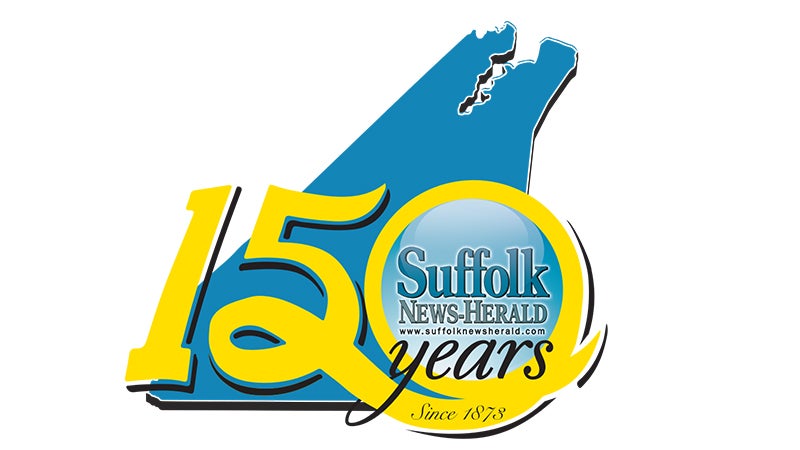Column – Change reaches Suffolk
Published 5:26 pm Tuesday, May 30, 2023
|
Getting your Trinity Audio player ready...
|
The mid-1960s news belonged to the schools.
In January 1963, Florence Bowser School was dedicated. It was one of several new schools built or renovated.
In July 1963, Nansemond County enacted school attendance rules. Early in the administration of Gov. J. Lindsay Almond, the General Assembly, as part of what came to be known as Massive Resistance to the school desegregation program, amended the state code to abolish compulsory attendance. Both Nansemond County and Suffolk had been without compulsory attendance laws since then. A new Suffolk attendance law took effect Sept. 6.
Later in the same year, Nansemond School Board raised teacher salaries. “The prospective increase will raise minimum salaries for degree-holding teachers from $3,900 to $4,000 a year. Maximum salaries for teachers with bachelor’s degrees will jump from $4,900 to $5,000.”
On June 17, 1964, the first three Black students were assigned to white schools in Suffolk. School started “uneventfully” Sept. 2. “Suffolk City schools were quietly integrated Wednesday for the first time as school opened. There were no incidents reported and none expected. Activity at all schools was normal. Two Black students entered the sixth grade at Jefferson and one the third grade at Randolph. William R. Savage Jr., superintendent of city schools, said today was the most successful opening day ever experienced, that pre-school planning had paid good dividends for everyone involved in the opening.”
Other areas of the city and country did not integrate so “quietly.” Civil Rights marches took place all accross the south. About 185 people from the Suffolk area attended the historic March on Washington for Jobs and Freedom on Aug 28, 1963. “At 9:45 a.m., by police estimate there were 25,000 demonstrators on hand. The gathering was obviously slow-paced by comparison with the advance estimates that 100,000 — maybe as many as 250,000 — would take part in the mile-long noontime march from the monument to the Lincoln Memorial. At 9 a.m., 11 special trains had pulled in, carrying 5,300 demonstrators. On the monument grounds, there was a carnival atmosphere. The whole area was heavily policed. Along a major part of Constitution Avenue, officers stood shoulder to shoulder. There were civil police and military police. Also available, if needed, were several thousand troops at military posts in the Washington area.”
In September 1963, Suffolk City Council adopted a resolution for Mayor Major T. Benton to appoint a bi-racial commission, a group of seven people with the purpose of seeking solutions to problems presented to the committee and “to bring together people from each race representative of the different areas of interest in the city.”
However in May 1964, protests took place throughout the city. At Planters Peanuts, over discrimination in pay, “pickets at Planters lay across Norfolk and Western spur lines leading into the Standard Brands distribution center in an effort to stop the removal of six box cars from the center. Large crowds of Blacks jammed East Washington Street early last night, and police were flooded by complaints from motorists of broken windshields and windows, rocks, bricks and occasional garbage cans were thrown at the automobiles of motorists through the area, and windows at buses were reported broken by rocks and bricks thrown by the crowd.”
Likewise a three-day boycott of Suffolk buses took place, “Stoning of buses and breaking of bus windows” as well as multiple incidents were reported of potential riders being threatened at bus stops, but no injuries or arrests were reported.
Downtown businesses were not immune to the changes happening. “A selective buying program, boycotting businesses where no efforts had been made to practice or encourage fair employment policies,” was planned and coordinated.
As tensions rose nationwide, the question of military involvement was addressed. “U.S. Defense Secretary Robert McNamara did not specifically forbid members of the armed forces from demonstration in civilian clothes while off duty, but he did say none may demonstrate when the activities constitute a breach of law and order, or when violence is reasonably likely to result.”
As social change swept the nation, advances in technology, medicine and space discovery progressed almost as rapidly.
On April 15, 1964, the Chesapeake Bay Bridge-Tunnel opened. The $200 million, 17.6-mile long bridge-tunnel linked Virginia’s mainland and the Eastern Shore for the first time in history. The American Society of Civil Engineers designated the new crossing one of the “seven engineering wonders of the world.”
On the space frontier, weather satellites are launched into orbit. Tiros 7 transmitted photos of clouds taken from space. The weather satellites were launched in hopes of expanding hurricane and typhoon forecasting.
Several months later, with the objective of a moon landing, Ranger 7 photographed the moon before crashing into it, giving the world the first close up images of the moon’s surface taken from orbit.
Medical research had turned the battle to cancer. Further developments were made in understanding the structures of the basic core of all viruses — specifically the nucleic acids DNA and RNA. These discoveries were “probably more significant, if less appreciated by the public, than the unlocking of atomic energy.”
In Suffolk, businesses and buildings were going up along Main Street. In August 1963, the new Woolworths opened in Suffolk, located on the site of the old City Market on North Main Street. The new building more than doubled the size of the former Woolworths store on West Washington. Several public parking lots were also constructed. Legmans built a new store on Main Street where the Palace Theater had been, and Seaboard Bank began building its modernized bank.
To help citizens find everything and everybody they were looking for, a new city directory was under way in 1964. A house-to-house canvass was made by the enumeration team, and at all homes where they received no response, they left a slip containing the information needed for the individuals to complete.
Some issues read the same in the mid ’60s as they do to this day. “The blocked-crossings have long been a problem in Suffolk. Interest in finding a solution was heightened when a disabled Norfolk and Western Railway coal jack blocked many of the town’s crossings for a considerable period of time.”
The Nation gasped on Nov. 22, 1963, when President John F. Kennedy was assassinated. Citizens then watched as troops were sent to Vietnam, U.S. bombers attacked Vietnamese boats and returning ground fire shot down multiple American planes. The conflict in Vietnam was exploding.




